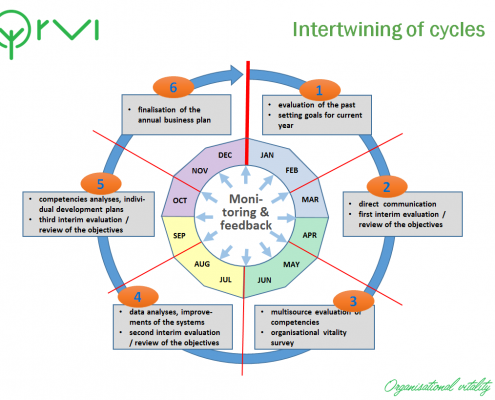The intertwining of HR processes through annual cycles
Many HR processes are directly integrated into the annual operating cycle of a company. This is especially true for the systems for managing the employees. The content of these systems directly relates to the current business plan.
Each company has its own specifics in regards to the annual cycles, the presented example is for illustrative purposes only. The year is divided into six equal parts.
Let’s start in the period six, i.e. at the end of the previous year. During this period, we completed the annual business plan for the current year. We consider the business plan as the main coordinating document between business areas and major projects. It is very useful if the annual business plan in addition to the financial tables at the level of the company also defines tasks and major projects that will be implemented. Special attention should be paid to the coordination of the interdependencies between areas.
At the beginning of the year, in the period one, top-down through the hierarchy we conduct the annual target interviews. We assess the achievements of the previous year, and based on the findings and on this year’s business plan we set annual targets for the current year. For the first quarter, we elaborate the expectations more in detail. That then makes real-time feedback and performance evaluation easier.
Into the second period we placed two things. Management communicates the business results of the previous year and the expectations, objectives, business context for the current year. This is followed by the first interim evaluation / review of the objectives and elaboration of the expectations for the second quarter.
In the third period, we perform the annual survey of organizational vitality, and (if needed, and for the selected target group) the multisource evaluation of behaviours / competences.
In the fourth period, the leaders carry out the second interim evaluation / review of the objectives and elaborate the expectations for the third quarter. In regards to holiday time the managers have to be quite flexible, which we have to take into account when we design the system. Over the summer, we find some peace to analyse the data collected from the survey and to prepare action plans for the autumn and beyond.
In the fifth period, we conduct the development part of the annual interview, to which we will probably also attach the third midterm evaluation / review of the objectives. In the development part, we use all the available information (vitality survey, competence evaluation, work performance history, training history, etc.). We look for development measures that will increase the performance of the individual. As always, in the interim evaluation / review of the objectives we elaborate the expectations for the next quarter.
Here we are again in the sixth period. Preparation of the annual business plan for next year is in full swing. The information collected from human resources processes are included into the basis for planning: findings on the state of the organizational vitality, general and individual state of competences, general and individual state of performance, information on the state of the labour market, etc.
A year passes by really quickly, right?






